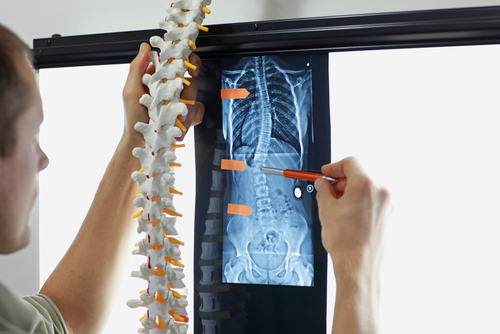Scoliosis, a condition characterised by an abnormal curvature of the spine, is commonly associated with adolescence and often fades away as individuals reach adulthood.
However, for some unfortunate individuals, the effects of scoliosis persist well into adulthood, causing discomfort, pain, and a range of other physical limitations.
From non-surgical methods to surgical interventions, we will uncover the latest advancements, research, and recommendations to help those affected by adult scoliosis make informed decisions about their health and well-being.
Modern Scoliosis Treatment Options
Modern scoliosis treatment in adults encompasses a range of approaches tailored to the individual’s age, the severity of the curvature, and other factors. These treatments aim to correct or manage the spinal curvature and improve the patient’s quality of life. Here are some of the modern scoliosis treatment options:

- Observation and Monitoring: For mild cases of scoliosis, especially in adolescents who are still growing, healthcare providers may recommend regular monitoring and observation. X-rays and physical exams help track the progression of the curvature.
- Bracing: Bracing is a standard treatment for moderate scoliosis in growing children and adolescents. The brace is custom-made and designed to apply corrective pressure to the spine, preventing further curvature progression. The type of brace and the duration of wear depend on the individual’s condition.
- Physical Therapy and Exercises: Physical therapy and scoliosis-specific exercises are essential to scoliosis treatment. These exercises improve posture, spinal strength, flexibility, and physical well-being. They may help manage symptoms and improve spinal health.
- Surgery: In severe cases of scoliosis (curves greater than 40 degrees) or when non-surgical treatments are ineffective. Modern surgical techniques, such as spinal fusion with instrumentation, aim to straighten the spine and stabilise it using rods, screws, and bone grafts.
- Minimally Invasive Surgery: Some patients may be candidates for minimally invasive surgery involving smaller incisions and reduced tissue disruption compared to traditional open surgery. This approach often leads to faster recovery times and less postoperative pain.
- Tethering (VBT): Vertebral Body Tethering (VBT) is a newer surgical technique aiming to correct scoliosis more flexibly than traditional fusion. It involves placing a flexible cord along the spine, allowing spinal motion while correcting the curvature.
- Casting (Mehta Casting): Casting is used in young children with infantile or juvenile scoliosis. Under anaesthesia, a cast is applied to the body, guiding spinal growth and preventing curve progression. The cast is periodically adjusted as the child grows.
- Spinal Orthotics: Custom-made orthotic devices like braces or spinal orthoses can support and help manage spinal curvature, particularly in adolescents.
- Pain Management: Individuals with scoliosis-related pain may benefit from pain management techniques, including medications, physical therapy, or injections.
- Psychological Support: Coping with scoliosis can be emotionally challenging. Psychological support through therapy or counselling can help individuals manage the emotional aspects of the condition.
- Biologics: Emerging treatments like biologics, which use biological substances to promote bone growth and fusion, are being explored as potential options for scoliosis management.
The choice of treatment depends on various factors, including the type and severity of scoliosis, the age of the patient, and individual preferences. Modern scoliosis treatment options aim to correct or manage the condition while minimising discomfort and improving the patient’s overall quality of life. Treatment decisions should be made in consultation with a healthcare provider or scoliosis specialist.
Choosing the Right Scoliosis Treatment

The first step is to understand your specific condition, which involves knowing the degree of curvature, age, and underlying cause of scoliosis. Is it mild, moderate, or severe? Are you still growing, or have you reached skeletal maturity? This information will guide your treatment options. Seek out experienced healthcare providers, particularly those who specialise in scoliosis treatment. These experts can comprehensively assess your condition and discuss the pros and cons of each treatment option in the context of your unique situation. They can help you understand each approach’s potential risks and benefits and provide recommendations based on your needs.
Consider how each treatment option may impact your daily life. For example, bracing requires a significant time commitment, often involving wearing the brace for several hours a day. Surgery, on the other hand, involves a more extended recovery period. Think about how these treatments align with your lifestyle, school, work, and social activities. Balancing short-term and long-term considerations is crucial. Some treatments may provide immediate benefits regarding curve correction, while others may focus more on preventing further progression. Discuss your goals and expectations with your healthcare team to ensure the treatment aligns with your desired outcomes.
Feel free to seek a second opinion if you have doubts or questions about the recommended treatment. Ultimately, the decision should be made carefully considering all relevant factors, and you should feel comfortable and well-informed about the chosen path forward.
Connecting with Others: Support Groups and Resources

Connecting with others with similar experiences can be a valuable source of support and information for individuals navigating adult scoliosis. Support groups provide a platform for individuals to connect, share their stories, and gain emotional support from others who understand their challenges. These groups often consist of individuals with firsthand experience with adult scoliosis, whether undergoing treatment or having undergone surgical interventions. By joining such support groups, individuals can learn from others’ experiences, gather information about treatment options, and find comfort in knowing they are not alone.
In addition to support groups, there is a wealth of resources available to individuals with adult scoliosis that can help guide them in their treatment options. These resources include reputable websites, medical literature, and research papers that provide information about the latest advancements and treatment options for adult scoliosis. By accessing these resources, individuals can educate themselves about the various non-surgical and surgical interventions available, understand each option’s potential benefits and risks, and make informed treatment plans. These resources can also provide valuable information about finding specialised healthcare professionals, clinics, and hospitals that specialise in managing adult scoliosis, ensuring individuals receive the highest quality of care.





